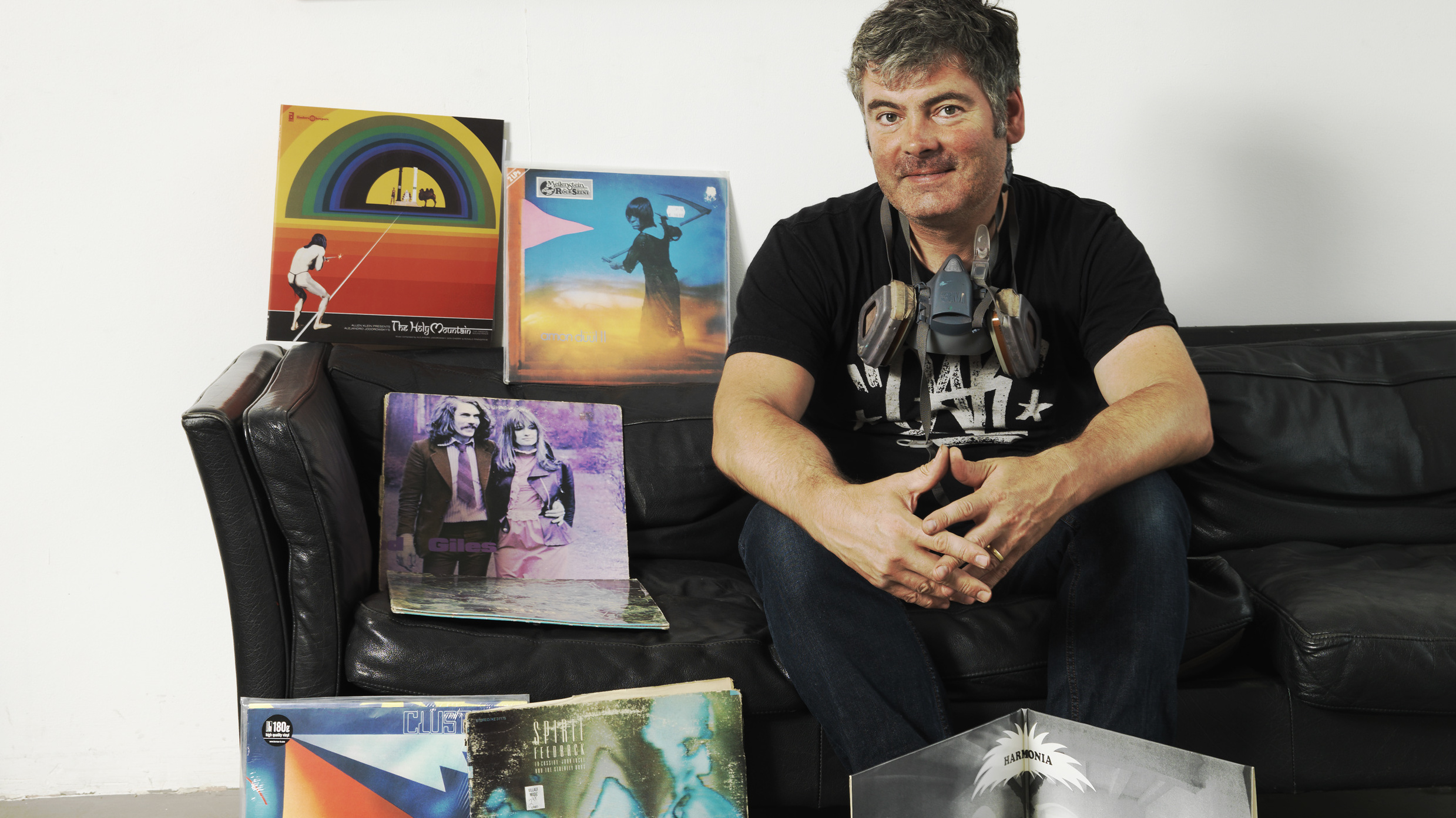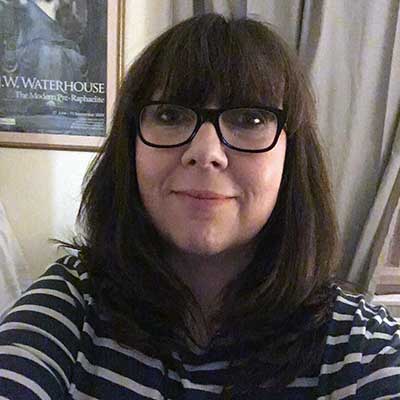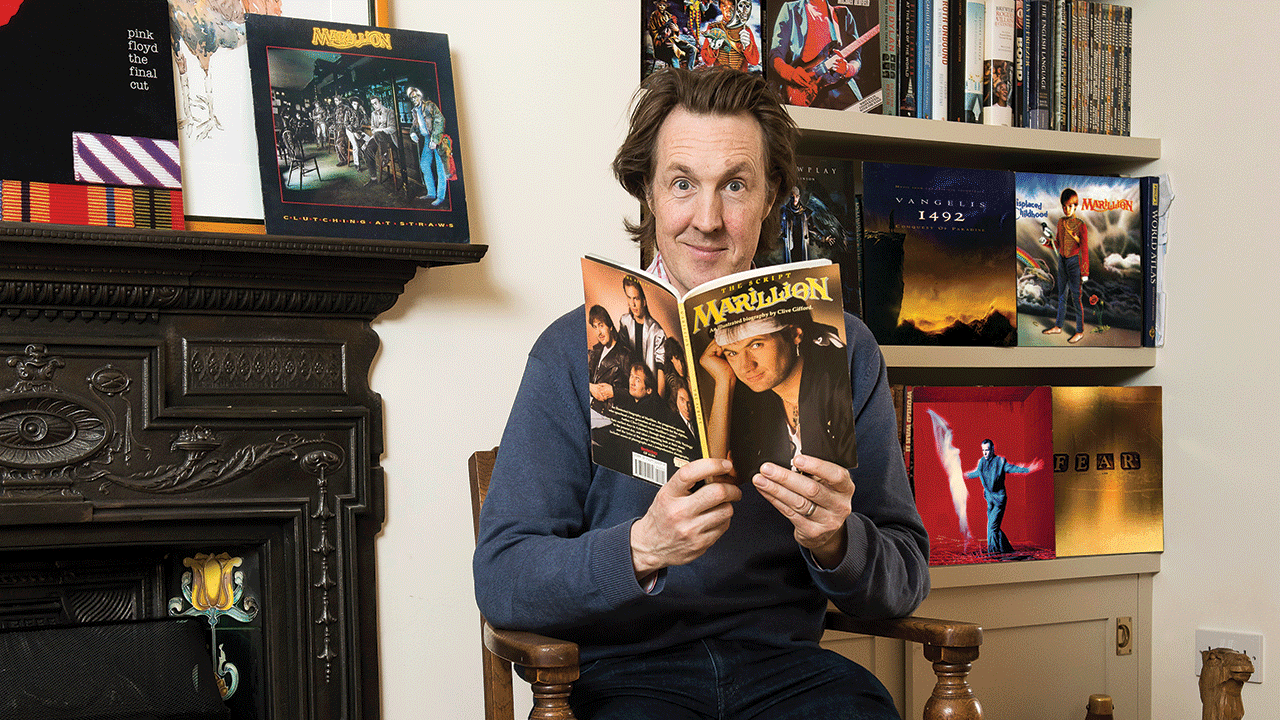Artist Charles Uzzell-Edwards let us rummage through his record collection
Street artist and gallery owner Pure Evil (actually a very polite Charles Uzzell-Edwards) gives us a guided tour of his record collection

“My godmother worked as a record reviewer for The Sunday Times and she was always giving me records she’d reviewed and thought I might like. I ended up with a lot of quite strange seven-inches from the 70s and 80s and that kind of started my record collection. I was also listening to John Peel, and recorded things off his radio show. When you listened back, the first five or 10 seconds were missing because you’d go, ‘Oh, this is a good one!’ without time to record the first part. He’d play such a mixture – punk, electronic, reggae – that I began to get a taste for bands like Can and Neu!.
As a kid I was the only New Romantic in the village. I was in the mountains of Swansea Valley, surrounded by Iron Maiden fans. I wanted to be glamorous, wear eyeliner and hang out with Steve Strange at the Wag Club in London. The thing that defined you was your musical taste – and dressing strange, standing out. I did a talk about this recently in London and a man said to me, ‘I understand how you feel, I’ve come all the way from Alabama’ – he was a black guy with long dreadlocks. When you’re making an identity, music is a strong part. When you’re walking around town, what album are you going to carry under your arm? Mine would have been The Smiths, who I was very into at that time.
In 1990, after university in London, I got a job and moved to San Francisco and started hitting the record shops. You’d find your way by the cover – if you see a bottle of wine with a decent-looking label you probably think it’s worth drinking because it’s got a nice castle on it and a bit of gold. Sleeves were the same. Obscure electronica like Terry Riley helped me get more into electronic music. A rave/dance scene was exploding there and a lot of people had left the UK to go to California for it. There was a weird social mix: heads from the mountains who were concocting strange chemicals, a Silicon Valley contingent who were into virtual reality, then sound systems and people throwing parties who were making their own music too.
- Meet the best turntables for your record collection
- Smaller budget? No problem! These are the best budget turntables
I would consider Spirit’s Feedback my first prog album. They definitely pushed rock music forward. When I used to do drama the coolest guy in the class played Spirit and one song, Mellow Morning, was amazing. This album started my love of gatefold albums with a nice big photograph in the centre. Through my crate-digging in San Francisco I found this great gatefold, McDonald And Giles – and what a line-up of people they used. Here was another way to discover music: I saw Steve Winwood in the credits, so I went to explore Traffic, and then you fixate on years. 1971 and 1972 seemed to be golden years for music, so I’d search for that, or for Cotillion Records all just from one album.
In San Francisco I discovered drum machines. A friend had a Roland 606 and I thought, ‘What is that?’ I realised you could make electronic music yourself so I bought a Sequential Circuits keyboard to use when I was DJing, then started collecting drum machines. German bands became very important to me again. Listening to something like Edgar Froese’s Aqua I’d try and work out what equipment he used. Usually it’ll say on the sleeve. Now, the internet will tell you all the pedals used. Post-war, these bands were in conditions where they wanted to break away from the tradition of their fathers to create something new; the same with the Dadaists in Cologne after World War I. I find with creativity, if you’re in a mellow place it’s less conducive than being somewhere dirty, challenging. You need that dirt to help things to grow.
For amazing electronic music you have to hear John Carpenter. I’ve been intrigued by him since the early 80s when I found myself really moved by some of the music in his films and it made me want to find out more – it was great to discover he could compose too. Goblin have something special, then there’s the score for Holy Mountain – that’s [director] Jodorowsky with Don Cherry, who’s getting a chance to do something completely different. In San Francisco I would do chill-out rooms. The main room was the ‘doof-doof-doof’ room, which had three turntables and two CD players in it and was filled with beanbags and balloons. People would be dry-humping on the beanbags while I’d mix soundtracks, the Moon landings, whale noises, Edgar Froese and spoken word. This set me off making music in a little studio for [ambient artist] Pete Namlook from FAX records in Frankfurt [as Drum Machine Circle]. I’d go over there to collaborate. I’m self-taught, mainly from experimenting. I don’t get excited by reading manuals, I just turn things on and make noises, like cavemen hitting the log, see what happens. Usually you get more interesting results.
I’ve always got a soundtrack to work to. Recently I was obsessing about David Bowie’s Blackstar and its use of jazz. Bowie had been talking about how he was inspired by Kendrick Lamar and people like that who push music into different directions. The day of the release of Blackstar I had a Bowie print that I paused on and put away for some reason. Two days later he had died, I felt what I’d done had very strange timing. In my art I like to work a lot with images of musicians – I’ve done Lennons, Jaggers and now Elvis, and I’m currently obsessing about him.
Sign up below to get the latest from Prog, plus exclusive special offers, direct to your inbox!
In the gallery right now I have an exhibition by [US artist] Deedee Cheriel. She uses birds and animals, a world within a world with a little surrealism, and the images work with ambient, abstract music. I’ve done exhibitions before where I’ve composed music especially for it in my attic studio at home.
I recently read a new book about Krautrock. Yes, I’ve read Krautrocksampler – my cousin is [author] Julian Cope, but I’ve only met him once when I was young and we went to his family’s farm. Consequently I’ve gone back to listening to Harmonia, Kluster and Amon Düül. I went back to Cologne a while ago and found a lot of high-quality vinyl, anything on Brain records is good. Krautrock endures; always stays fresh and catches the ear. In 2001⁄2002, when I’d DJ tracks like Hallogallo at Dream Bags And Jaguar Shoes in Shoreditch, people would constantly come up and ask, ‘What’s this record?’ I’ve been playing a lot of Faust recently, really weird stuff that properly challenges you. I still need to hear tracks that have sounds from nowhere, an abstract weirdness. That’s all part of the art.”
Pure Evil is exhibiting at Proud King’s Road until August 7. Visit the gallery website for more.
My Record Collection: Michael Legge, the Smiths fan who LOVES Marillion…
Jo is a journalist, podcaster, event host and music industry lecturer who joined Kerrang! in 1999 and then the dark side – Prog – a decade later as Deputy Editor. Jo's had tea with Robert Fripp, touched Ian Anderson's favourite flute (!) and asked Suzi Quatro what one wears under a leather catsuit. Jo is now Associate Editor of Prog, and a regular contributor to Classic Rock. She continues to spread the experimental and psychedelic music-based word amid unsuspecting students at BIMM Institute London and can be occasionally heard polluting the BBC Radio airwaves as a pop and rock pundit. Steven Wilson still owes her £3, which he borrowed to pay for parking before a King Crimson show in Aylesbury.

